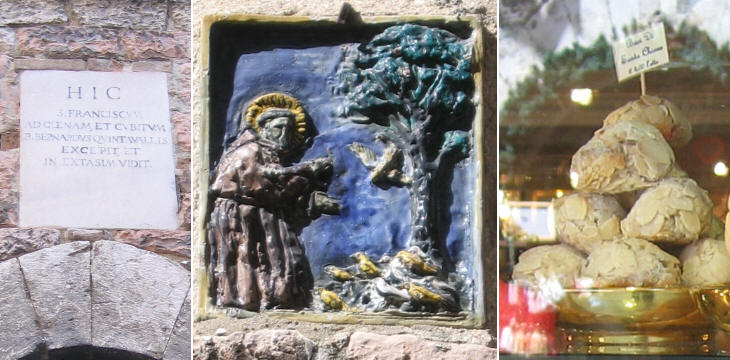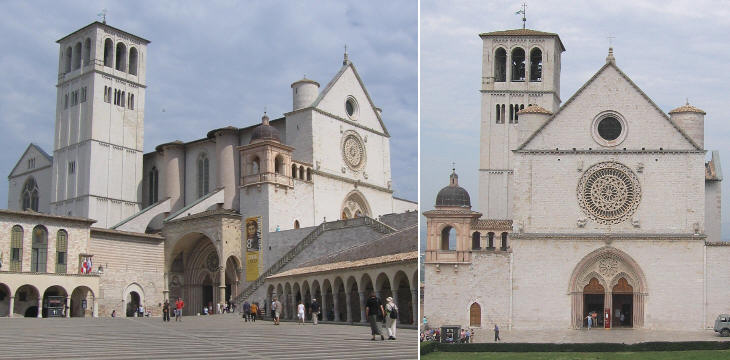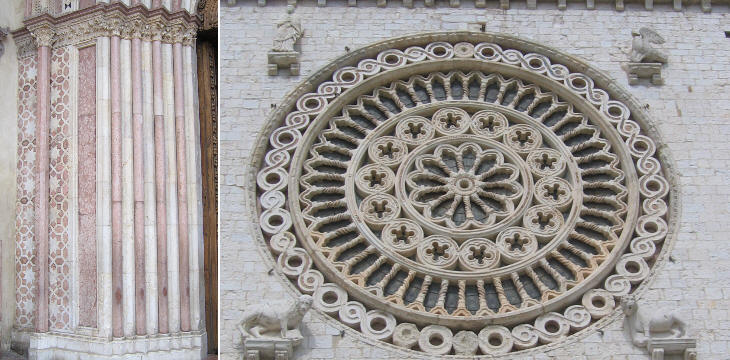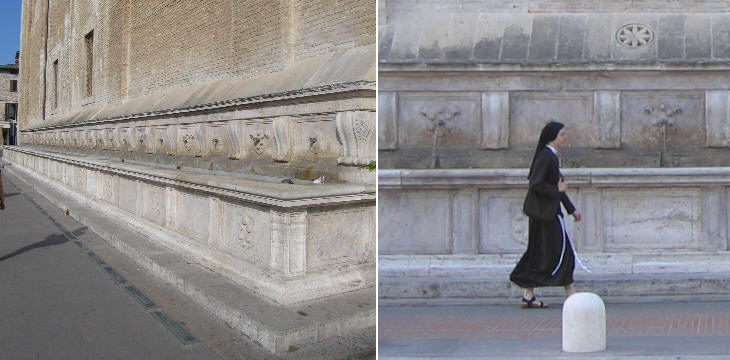
All images © by Roberto Piperno, owner of the domain. Write to romapip@quipo.it.
Notes:
Page revised in March 2022.

All images © by Roberto Piperno, owner of the domain. Write to romapip@quipo.it.
Notes:
Page revised in March 2022.
 Assisi - page three: St. Francis
Assisi - page three: St. Francis
You may wish to see pages on the fortifications and the old town first.

St. Francis: (left) an inscription on the house where he met Bernardo Quintavalle, his first follower; (centre) a modern glazed tile portraying St. Francis preaching to the birds; (right) a cookie named after S. Chiara
St. Francis is for Assisi what Mozart is for Salzburg; there is not yet a chocolate filled with marzipan named after him,
but there is already pane di S. Francesco, a cake filled with candies and also Baci di S. Chiara, a cookie named after Chiara, one of St. Francis' first followers (St. Clare of Assisi).
St. Francis (1181-1226) was the son of Pietro di Bernardone, a wealthy merchant of Assisi:
Francis had the opportunity to receive a proper education; he joined a military expedition against Perugia and in general he spent his youth in a rather carefree way. In his early twenties he had a spiritual crisis; after a pilgrimage to Rome,
while he was praying at the small and ruined church of S. Damiano outside Assisi, he had a mystical experience which led him to give up all his possessions and to break his family ties; he lived for years as a beggar, taking care of the restoration of S. Damiano and other small churches including a small chapel dedicated to S. Maria degli Angeli, which due to its size was known as la Porziuncola (the small thing).
St. Francis lived at a time during which the Cathar heresy claimed that the original purity of the Christian faith had been betrayed; this heresy was spreading to many parts of Italy from its main centres in southern France.
In 1209 Pope Innocent III promoted a crusade against the Cathars.
In that same year St. Francis started preaching a life of repentance and poverty and was joined by his first follower, Bernardo Quintavalle; this event is celebrated by an inscription on the house where Bernardo lived. Other events of St. Francis' life are celebrated by modern images many inhabitants of Assisi place next to the entrance of their homes.

The paintings in the churches and the sacred images along the streets of Assisi are very often dedicated to St. Francis and St. Clare; the only other saint who is the object of a particular devotion is S. Roch, who died of plague while helping the sick: he is portrayed in the act of showing the sore on his thigh which was the first sign of his illness: the devotion to S. Roch is explained by the many pestilences which struck the region.

S. Francesco: lower and upper churches
Henry James visited Assisi in 1874 nearly a century later than Goethe: although he praised Tempio della Minerva which had raised the enthusiasm of the German traveller, he was more intrigued by the
two churches built starting in 1228 to house the tomb of St. Francis:
This twofold temple of St. Francis is one of the very sacred places
of Italy, and it would be hard to breathe anywhere an air more heavy with holiness. (..) Such seems especially the case if you happen thus to have come from Rome, where everything ecclesiastical is, in aspect, so very much of this world - so florid, so elegant,
so full of accommodations and excrescences. The mere site here makes for authority,
and they were brave builders who laid the foundation-stones.
The thing raises straight from a steep mountain-side and plunges
forward on its great substructure of arches
even as a crowned headland may frown over the main.
... Entering the lower
church at the bottom of the great flight of steps which leads to the upper door,
you seem to push at least into the very heart of Catholicism." (Italian Hours).

S. Francesco: (left) Lower Church: detail of the entrance; (right) Upper Church: the rose window
The two churches, together with elements of the Umbrian tradition, show evidence of Gothic architecture, most likely due to the fact that Haymo of Faversham, who led the Franciscan Order between 1241 and 1243, called in French master masons.
Clare heard Francis preaching in the streets of Assisi and was moved by his words. After having lived for a while in a Benedictine nunnery, Clare founded the Order of Poor Ladies,
or of S. Damiano where she settled with her followers; they lived in seclusion. The name of the order was later on changed by Pope Urban IV to the Order of St. Clare.
The large church where she is buried was completed just a few years after her death and it
was consecrated in 1265 by Pope Clement IV. The use of white and pink stones plays a major role in its decoration, a feature one can see also in many churches of Foligno.

S. Maria degli Angeli: (left) Late Renaissance dome and Baroque bell tower; (right) XIXth century façade
About two miles below the town stands the huge memorial church of Santa Maria degli Angeli, built in the sixteenth century to enshrine the little chapel of St. Francis; but, as it was destroyed by the great earthquake of 1831, Gregory XVI caused it to be rebuilt, on the plan of St. Peter's in Rome, by the architect Poletti. It is colossal in its proportions and tasteless in its design. There could be no greater or more glaring contrast than that which it presents to the beautiful old town above it. It is a modern edifice, devoid of all religious sentiment or feeling of devotion. The idea it suggests to the beholder is, "What an immense amount of money it must have taken to build it!"
Ferdinand Gregorovius - An excursion through Sabina and Umbria in 1861 - Transl. by Dorothea Roberts
In 1569 La Porziuncola, the small countryside chapel dear to St. Francis, was enclosed in a very large church commissioned by Pope Pius V, similar to what had occurred at Loreto, a century earlier. Its elegant Renaissance dome was designed by Galeazzo Alessi, who was advised by Vignola, one of the major architects of that period; the bell tower was added in 1679.
In 1832 an earthquake caused the fall of the main nave and of the façade: they were rebuilt by Luigi Poletti in 1836-1840, but in 1925-1930 the façade was modified by Cesare Bazzani: his magniloquent style could not have been less appropriate for a church celebrating the preacher of poverty.

S. Maria degli Angeli: Medici fountain
Assisi and in particular la Porziuncola attracted many pilgrims and this explains why a long fountain was built on one side of the church. It was donated in 1610 by Cosimo II, Grand Duke of Tuscany and it was decorated with his family's (the Medici) coat of arms.
S. Damiano is most likely the only place in Assisi where St. Francis would feel his message has not been betrayed or misunderstood. Here the saint had his first mystical experience, here he is said to have written Cantico delle Creature (Praise of the Creatures), one of the first literary works in volgare (early Italian language), here St. Clare built a small nunnery next to the chapel.
CANTICO DELLE CREATUREAltissimu, onnipotente bon Signore, Tue so' le laude, la gloria e l'honore et onne benedictione.
* * *Most High, Omnipotent, Good Lord,
To Thee alone, Most High, do they belong
May Thou be praised, my Lord, with all Thy creatures,
And he is beautiful and radiant with a great splendor,
May Thou be praised, my Lord, for sister moon and the stars,
May Thou be praised, my Lord, for brother wind,
May Thou be praised, my Lord, for sister water,
May Thou be praised, my lord, for brother fire,
May Thou be praised, my Lord, for our sister, mother earth,
May Thou be praised, my Lord, for those who forgive for the sake of Thy love,
Blessed those who endure them in peace,
May Thou be praised, my Lord, for our sister, bodily death,
Woe to those, who die in mortal sin:
Praise and bless my Lord, (translation by Fr. Kajetan Esser - A Publication of The Franciscan Archive) |
Background image for this age: rose of S. Chiara.
Return to page one (the fortifications) or page two (the town) or take the train and reach Perugia.

